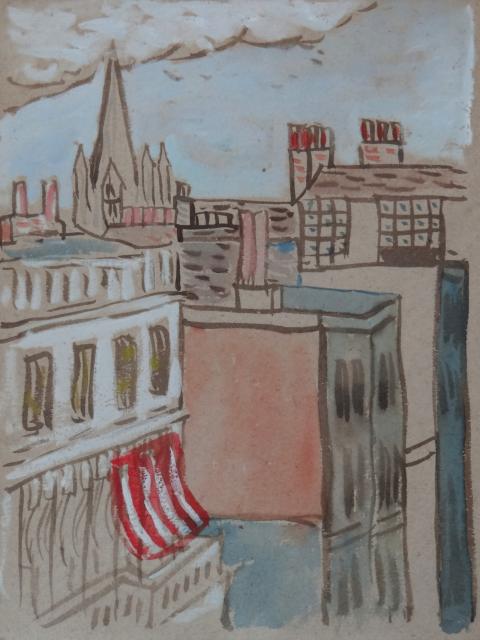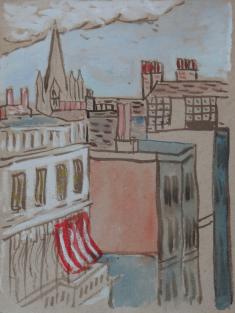Raymond McIntyre (NZ)
Cityscape with Red Awning, n.d.
Once Raymond McIntyre reached London in 1909 and began to immerse himself in the European art world his eyes were opened and his painting took strong and long strides in the direction of the post-impressionist avant-garde. Cityscape with Red Awning has all the confidence and informal character of en plein air sketching which the Barbizon school and then the impressionists – for whom working in natural light became particularly important – had made so influential from the mid-19th century. But there is more to this watercolour than immediacy. Following the direction of Les Nabis (1888-1896), who had in turn built upon the example of Cézanne and the encouragement of Gauguin, McIntyre arrived at the point where linear perspective and modelling almost disappear; and a flattened, decorative surface of grid-lines and colour planes emerges.
Composed by the artist from the high vantage point that a cheap flat or an artist’s studio would afford, the cityscape is transformed into a composition of lines. The shapes of buildings, windows, roofs and steeples are recognisable but each is flattened – drawn in outline, patches of over-all pattern and confident planes of transparent colour. All this makes us acutely aware that we are looking at a flat painting surface rather than gazing into an illusionistic space. We know that one building is in front of the next, and the buildings are in front of the sky, and so on; and the artist knows we know all this so he needs to do very little to make this a city-scape. Instead he can pile all his attention into making this more artefact than mimesis. Plus he even has the audacity to contradict what we know: notice how the ‘sky’ seems to come in front of the steeple.
The scene is cropped tight so that we do not see the ground plane recede into the distance. Diagonal lines are in the minority, making the painting a flattened grid of horizontal and vertical lines and rectilinear forms; and the patterns of windows reinforce this – especially the grids of studio skylights in the top right. Colours conspire to flatten the space too: white is introduced at the top to bring space forward; and the deepest blues which ought to be in the distance are reserved for the foreground buildings. McIntyre has made the visual language of the post-impressionist avant-garde all his own.
McIntyre left New Zealand to immerse himself in “the influence and stimulus of European art” and he would have probably, modestly, admitted that his work became, to use his own words, more interesting “viewed from the standpoint of modern artistic developments in Europe” as a result. Cityscape with Red Awning – a thoroughly modern work – confirms it.
Raymond McIntyre, Cityscape with Red Awning, n.d., watercolour, 280 x 210mm
Essay commissioned by International Art Centre, Parnell, Auckland, NZ; and published in Important, Early and Rare, 25 March 2015.

